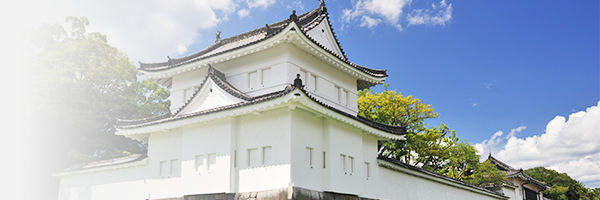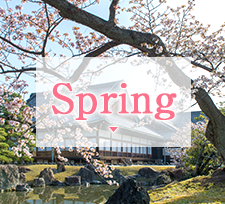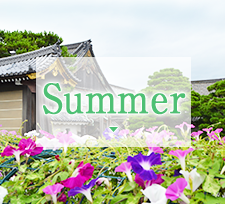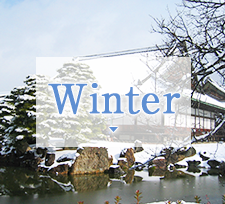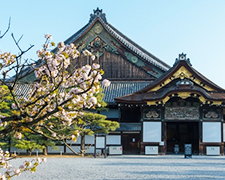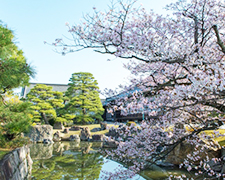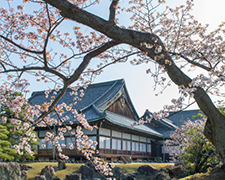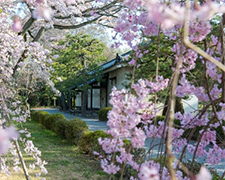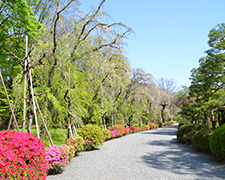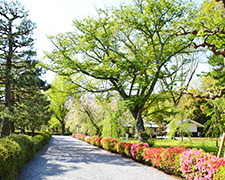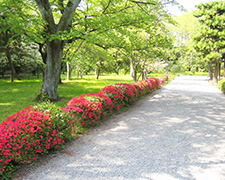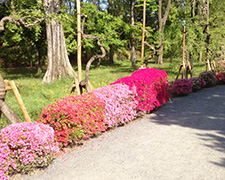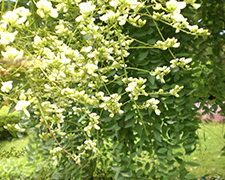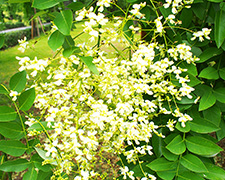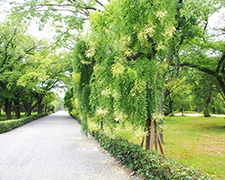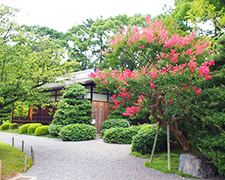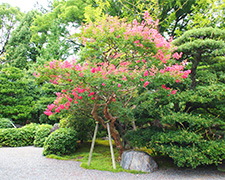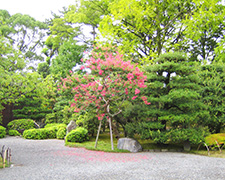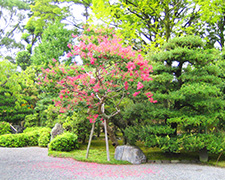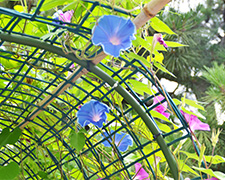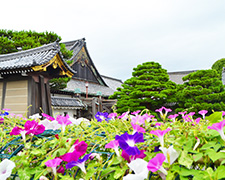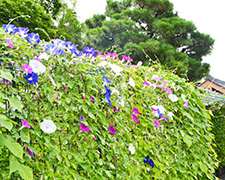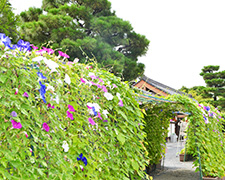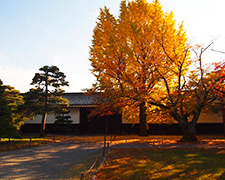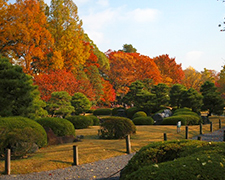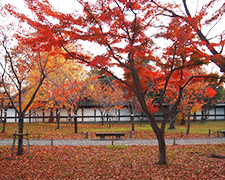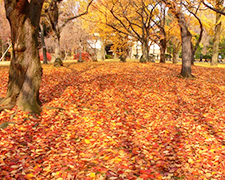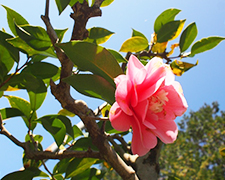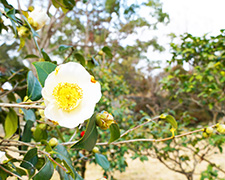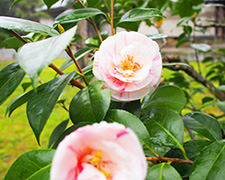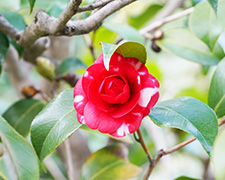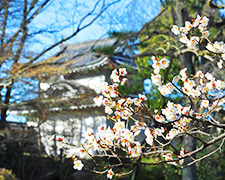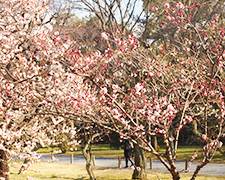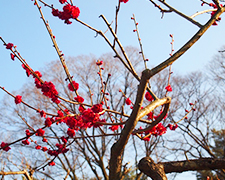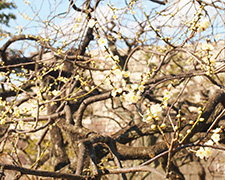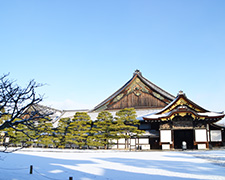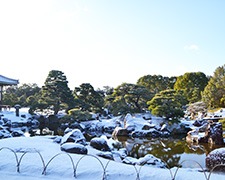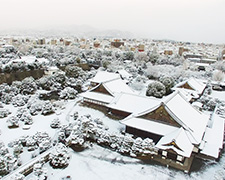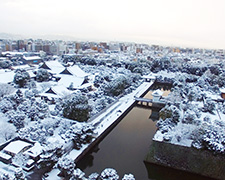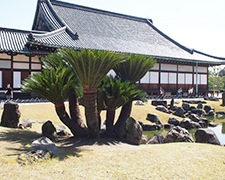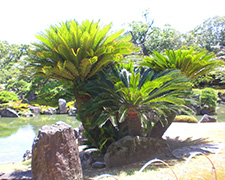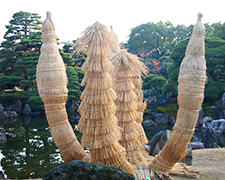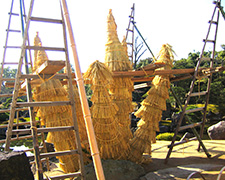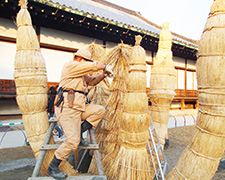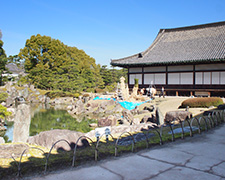Nijo-jo Castle offers many scenic features and flora unique to each season.
Spring
Cherry
From late March to April, visitors flock to Nijo-jo Castle for the blossoms of its 300 or so cherry trees, which include fifty varieties.
It is not known if any cherry trees were planted when the castle was originally built. The earliest confirmed mention of them appears between 1878 and 1881, when the castle, then managed by the Ministry of the Army, was recorded as having as many as 113 cherry trees. By the end of World War II, the number declined to just a few dozens. Most of the cherry trees we see today were planted between 1955 and 1965. The cherry trees are illuminated at night during the annual Nijo-jo Sakura Matsuri (Nijo-jo Castle Cherry Blossom Festival).
-
Bloom time
-
Yamazakura cherry and Somei Yoshino cherry
Late March to early April
Weeping cherry
Late March to Mid-April
Satozakura cherry
Early to late April
Rhododendron/azalea
There are many Kurume-tsutsuji bushes in the western parts of the grounds. Many are planted beneath Yaebenishidare cherries, and come into bloom just as the cherry blossoms begin to fall. Some Omurasaki-tsutsuji bushes can be seen in the Honmaru Garden, the Ninomaru Garden, and around the Ninomaru-goten Palace.
-
Bloom time
-
Late April to early May
Summer
Weeping Japanese pagoda tree
Often the subject of visitor queries, this deciduous tree is a variant of the sophora, and belongs to the pea family. It is traditionally believed to be an auspicious tree.
-
Bloom time
-
Late July to early August
Crape myrtle
This tree is known for its long bloom time. Two are planted inside Seiryu-en Garden, and one to the east of the Honmaru keep tower, where they continue to show off their dark red blossoms during a period when few other plants are in bloom.
-
Bloom time
-
Around July to September
Morning glory
This flower brings a refreshing coolness to the summer scenery.
-
Bloom time
-
July to August
Autumn
Fall colors
Nijo-jo Castle, planted with numerous deciduous trees, such as cherry, maple, ginkgo, and white enkianthus, is an excellent place to enjoy fall colors in all hues of red and yellow.
-
Fall color season
-
Late October to early January
Winter
Camellia
Camellias have been planted at Nijo-jo Castle since around 1953. In 1965, there were 620 camellia trees, including nearly 120 varieties. They were propagated from cuttings gifted by the Takeda Ichijoji Farm, Hokyoji Temple, and the Tokyo University of Agriculture Atsugi Farm.
As of March 2007, there were about 400 camellia trees, including roughly 90 varieties, of which 240 (80 varieties) can be seen between the Kita Nakashikiri-mon Gate and the west side of the Seihoku Dozo, where they are planted in high concentrations.
-
Bloom time
-
Around December to Mid-April
Plum
Most of the castle’s 100 or so plum trees can be found in the plum grove located in the southwestern part of the grounds. The plums were planted in 1954 at what used to be a grove of evergreen trees loosely referred to as kashi in Japanese. The plum grove was later expanded to the south side of the walkway. Blossom colors include red, white, and pink. Some varieties have blossoms of multiple colors on a single tree. There are also weeping varieties.
Plum fruits are harvested every year in partnership with local residents. The fruits are made into products, and proceeds from the sales are donated toward the upkeep of the castle.
-
Bloom time
-
Mid-February to late March (best between late February and mid-March)
Snowscape
Snow is a good reason to visit Nijo-jo Castle because the snow-dusted castle is a very rare and attractive sight.
Sago palm (Cycas revoluta)
History of Nijo-jo castle’s sago palms
The sago palms growing in the Ninomaru Garden were previously described as originally gifted by Nabeshima Katsushige (1580-1657), lord of Nabeshima domain (present-day Saga Prefecture). This is because a gift of one sago palm made by Nabeshima during the rule of the third Shogun Iemitsu, in anticipation of the 1626 imperial visit by Emperor Go-Mizuno-o, is recorded in a bakufu document known as the Tobu Jitsuroku. In 1997, a map of the Ninomaru Garden dating from the eighth Shogun Yoshimune’s rule (1716-45) was made public, in which the garden is shown planted with as many as fifteen sago palms. The position of one of these correspond with the current sago palms. There is no way of knowing if the present sago palms date from this period, but since they appear in photographs taken in the 1860s, it is presumed they are at least 150 years old.
Winter-proofing the sago palms
The sago palm is a tropical plant not tolerant of low winter temperatures. Nijo-jo Castle protects its sago palms from the cold by binding straw and straw sheets around the trunks. This gardening task, which has been conducted annually for at least 65 years, usually takes place sometime around late November to early December, and the know-how has been preserved since the days the castle was under the jurisdiction of the Imperial Household Agency. Both the operation and its result are eye-catching winter features of the Ninomaru Garden.
Map of Nijo-jo castle’s Trees and Flowering Trees
- Spring
- Summer
- Autumn
- Winter



